Technically, black holes have infinite density. Guess what the equation for density is? d = m/v. That means that the mass has to be infinite, or the volume has to basically be 0. 
Relativity and stuff
- Thread starter Drbretto
- Start date
-
The FTB Forum is now read-only, and is here as an archive. To participate in our community discussions, please join our Discord! https://ftb.team/discord
You are using an out of date browser. It may not display this or other websites correctly.
You should upgrade or use an alternative browser.
You should upgrade or use an alternative browser.
Yes. I divided by zero, had a seizure and for a brief moment I could contemplate infinity. It might have also been the weed.
You and me gotta hang out more.
I did this to really explain my theory to the other board, reposting here because this is the neatest thing I've ever written down. This is the rough draft.
All images shamelessly stolen or hastily drawn in MSpaint, so if I ever turned this into a blog post somewhere, I'd have to re-do the "artwork" but in the sense that this is just for a thread on a message board, this will do for now.
OK, here it is. This is as clear as I can get it, and I've expanded it so anyone can follow along, even if they don't have the scientific background. I think this is about as simplified and clear as I can get it, and I think the images will really help me translate from the abstract thoughts that run around in my head into a visual language that anyone can understand.
I'll start with spacetime. I will retouch on the examples I mentioned later, but I thought it would be easier to start with the basics, while demonstrating the connection from another angle to help set in that it's not just a mathematical connection.
Not to insult anyone's intelligence, but it's easier if we start from scratch:
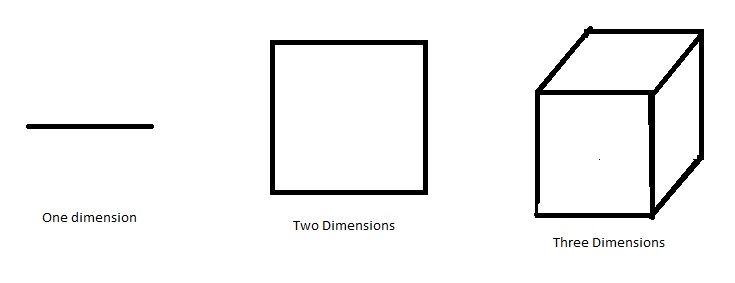
Now, our brains are pretty good at recognizing three dimensions in a 2D space. This is something our brains do for us, so you need to imagine yourself as a 2D person who has never seen a cube before. You wouldn't necessarily be able to recognize that it's a cube. This image should help visualize. You already know it's a cube, but try to just think of it as a bunch of triangles and trapezoids.

But, you can represent a 3-dimensional shape by imagining the 2-dimensional shadow left by the 3D object. In other words, substitute the dimension "depth" with the dimension "time" and you'll get this:


Which is much easier to recognize as more than just the shapes it is made out of. It's a clear representation of a 3D object in 2D space.
You can even take it a step further. Add one more spacial dimension to the cube and we can't process it with our feeble 3D brains. But, if we substitute the 4th dimension with time (the key ingredient in motion, more on that in a bit) we get this:

Which is called a hypercube. We're utilizing our brain's ability to interpret a 3D image on a 2D plane here, but that's a construct of your visual cortex. The 4th dimension is not properly perceptible without introducing the dimension of time. This is what the 3D shadow of a 4D hypercube would look like in 3D space.
The point here is to start thinking of time as an actual dimension. Not necessarily in space, but at least something that is intrinsically connected.
So, this leads back to my original examples. This will take out as much of the noise as is possible to isolate the concept.
Imagine a box, like a youtube video. This represents your perspective. When you see something that's closer to you, it will look bigger. We will start with a 2-D image of a 2D object. In fact, we can just keep the 3rd dimension out of this whole part right now. It's exactly the same thing, just in a different direction.
Start with this:
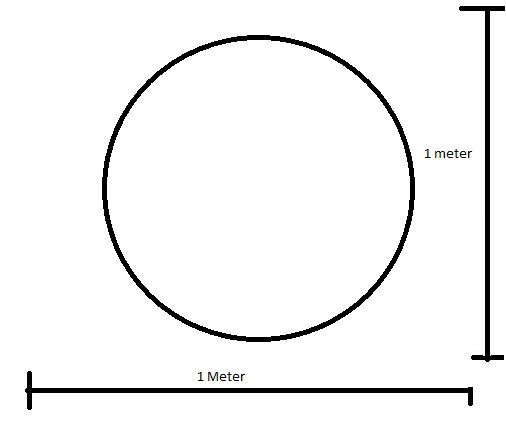
If you were to scale up the height of the circle, let's say by a factor of 2, but didn't scale up the width to go along with it, but still fit it into the same "youtube video" format, you would distort the image like so:
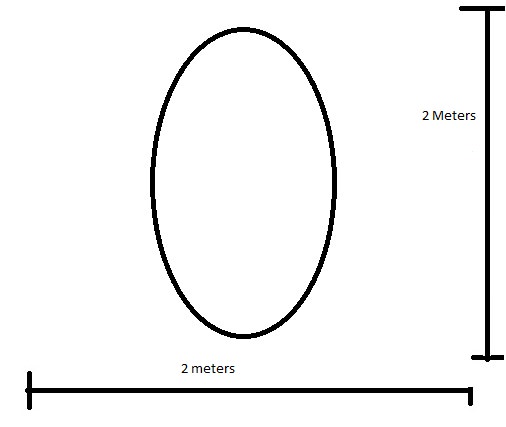
But, that breaks the symmetry. And we like things to be symmetrical. So, instead, you need to scale both dimensions of the image, and if you do so, you get the same picture as before. The only thing that has changed is the scale. You've multiplied both the x and y by 2. Like so:

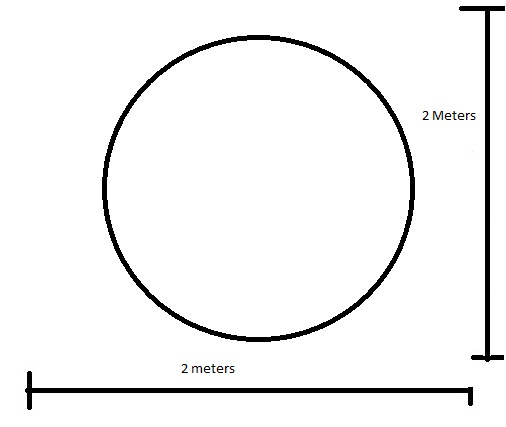
Which is literally the same image as the first one. All I did was change the scale from 1 meter to 2 meters. This is sort of what it would be like from your perspective if you were looking at a 1x1 meter object up close, and a 2x2 meter object twice as far away. In fact, that's how we perceive the 3rd dimension. The further out something gets, the smaller it is to the youtube video screen that is our perspective. This is actually part of the forumula for how videogames represent 3D images. It's, essentially, Instead of a 2D (X,Y), it's (X/z, Y/z).
So, let's add motion. We measure motion in a very simple formula. Speed = distance/time. And we can interpret that as Motion as a relation to spacial dimensions (distance) over time. IOW, the magical factor that makes a still image into something in motion is simply time (mathematically speaking. This isn't about the energy that drives something to move, rather simply the concept of motion itself). So, for the sake of understanding, let's call "motion" the injection of "time".
Let's apply that to my spiffy circle:
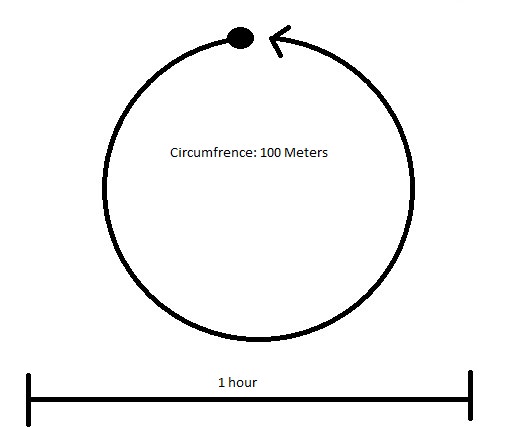
Here's the base form. I've removed the X and Y scales. You can infer them from the circumference of the circle. I needed to remove them so I had room to put in the time scale.
You're the dot and you're moving around this circle. This doesn't need to be a circle, btw. This has nothing to do with rotation, it's about the distance traveled. I only made it a circle so it's easier to fit into the square. This is a dot moving 100 meters in 1 hour.
If you were to scale up the X and Y of the circle by a factor of 10, but not the timeline, that same dot will move 100 meters, but your circle would just look like this:

But, if you scale the time along with the spacial dimensions, you come right back to the same original image:

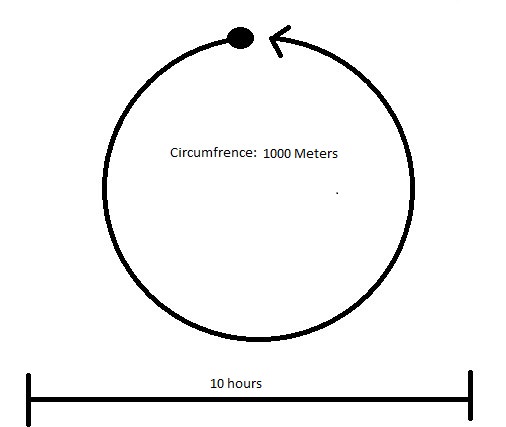
Just like when we scaled up the height and width on the 2-D circle. Alternatively, you could also just increase the speed of the dot, but that's just a way to circumvent having to mess with the time line, and only supports the concept that space and time are mathematically, and practically, interchangeable and intrinsically connected.
That's spacetime. Now, onto expansion.
Now, I'll let Spaceman go into the details of the mechanics behind how expansion works. For these purposes, it doesn't matter. As Lawrence Krauss jokes, assume the cow is a sphere, which is another way of saying, let's remove all these other little factors within the smaller space and assume total symmetry. As in, the shape of a rock floating in space doesn't matter for calculating its trajectory, so assume the rock is a sphere to isolate what we're talking about. This is what I have done with the circle all this time.
So, the short story is, space is expanding. Everywhere. And there is no such thing as the center. This is hard to visualize, but it's true. Everything is expanded away from everything else. Here's the best way I can describe it:
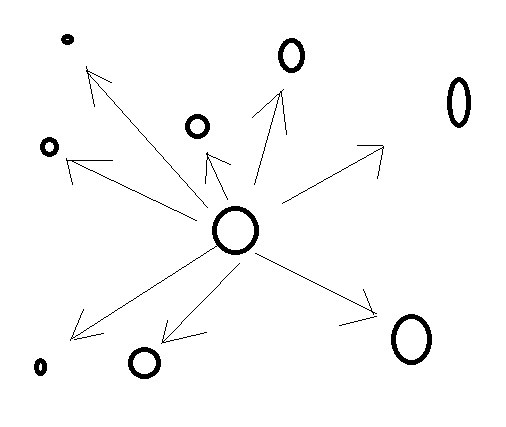
Each circle is a galaxy. And the center one is us. From our perspective, each of those circles is moving away from us at a steady, and amazingly enough, accelerating rate. What drives this expansion is referred to as "dark energy" and that's just a another word for "no idea". This does not pretend to explain that either.
But, it's not just from OUR perspective. It's from everything's perspective:
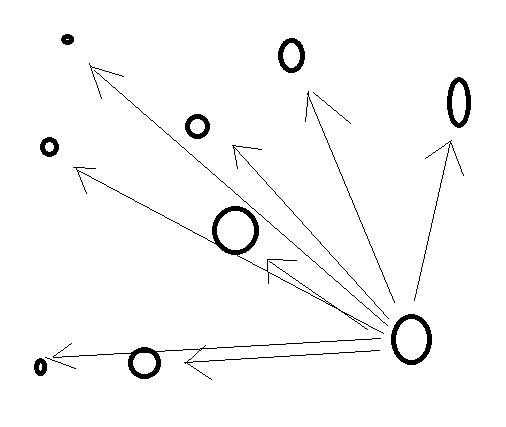
So, as counter-intuitive as this sounds, it is equally true to say that everything is moving away from us as it is to say that we are moving away from everything.
If we take our newfound concept of time being just a 4th dimension, then that means that not only are we moving away from everything in space, we are moving away from everything in time as well.
If you were to take any one point in spacetime, you are moving away from it. You could express this as:

The anchor point can be literally any point in the universe. In fact, it could literally mean *every* point in the universe. Because of expansion, any two points are always moving away from each other, all the time. And that works in every dimension. X. Y. Z.
And time. We are always moving in time in a single direction. Expansion MUST be the driving force behind the cosmic clock, or if you'd prefer, the river of time. Sure, you can "move through time" in relation to that river. Imagine a big raft floating down that river and you're moving to different seats. But, that raft is still floating forever in one direction on that river.
All images shamelessly stolen or hastily drawn in MSpaint, so if I ever turned this into a blog post somewhere, I'd have to re-do the "artwork" but in the sense that this is just for a thread on a message board, this will do for now.
OK, here it is. This is as clear as I can get it, and I've expanded it so anyone can follow along, even if they don't have the scientific background. I think this is about as simplified and clear as I can get it, and I think the images will really help me translate from the abstract thoughts that run around in my head into a visual language that anyone can understand.
I'll start with spacetime. I will retouch on the examples I mentioned later, but I thought it would be easier to start with the basics, while demonstrating the connection from another angle to help set in that it's not just a mathematical connection.
Not to insult anyone's intelligence, but it's easier if we start from scratch:

Now, our brains are pretty good at recognizing three dimensions in a 2D space. This is something our brains do for us, so you need to imagine yourself as a 2D person who has never seen a cube before. You wouldn't necessarily be able to recognize that it's a cube. This image should help visualize. You already know it's a cube, but try to just think of it as a bunch of triangles and trapezoids.

But, you can represent a 3-dimensional shape by imagining the 2-dimensional shadow left by the 3D object. In other words, substitute the dimension "depth" with the dimension "time" and you'll get this:


Which is much easier to recognize as more than just the shapes it is made out of. It's a clear representation of a 3D object in 2D space.
You can even take it a step further. Add one more spacial dimension to the cube and we can't process it with our feeble 3D brains. But, if we substitute the 4th dimension with time (the key ingredient in motion, more on that in a bit) we get this:

Which is called a hypercube. We're utilizing our brain's ability to interpret a 3D image on a 2D plane here, but that's a construct of your visual cortex. The 4th dimension is not properly perceptible without introducing the dimension of time. This is what the 3D shadow of a 4D hypercube would look like in 3D space.
The point here is to start thinking of time as an actual dimension. Not necessarily in space, but at least something that is intrinsically connected.
So, this leads back to my original examples. This will take out as much of the noise as is possible to isolate the concept.
Imagine a box, like a youtube video. This represents your perspective. When you see something that's closer to you, it will look bigger. We will start with a 2-D image of a 2D object. In fact, we can just keep the 3rd dimension out of this whole part right now. It's exactly the same thing, just in a different direction.
Start with this:

If you were to scale up the height of the circle, let's say by a factor of 2, but didn't scale up the width to go along with it, but still fit it into the same "youtube video" format, you would distort the image like so:

But, that breaks the symmetry. And we like things to be symmetrical. So, instead, you need to scale both dimensions of the image, and if you do so, you get the same picture as before. The only thing that has changed is the scale. You've multiplied both the x and y by 2. Like so:


Which is literally the same image as the first one. All I did was change the scale from 1 meter to 2 meters. This is sort of what it would be like from your perspective if you were looking at a 1x1 meter object up close, and a 2x2 meter object twice as far away. In fact, that's how we perceive the 3rd dimension. The further out something gets, the smaller it is to the youtube video screen that is our perspective. This is actually part of the forumula for how videogames represent 3D images. It's, essentially, Instead of a 2D (X,Y), it's (X/z, Y/z).
So, let's add motion. We measure motion in a very simple formula. Speed = distance/time. And we can interpret that as Motion as a relation to spacial dimensions (distance) over time. IOW, the magical factor that makes a still image into something in motion is simply time (mathematically speaking. This isn't about the energy that drives something to move, rather simply the concept of motion itself). So, for the sake of understanding, let's call "motion" the injection of "time".
Let's apply that to my spiffy circle:

Here's the base form. I've removed the X and Y scales. You can infer them from the circumference of the circle. I needed to remove them so I had room to put in the time scale.
You're the dot and you're moving around this circle. This doesn't need to be a circle, btw. This has nothing to do with rotation, it's about the distance traveled. I only made it a circle so it's easier to fit into the square. This is a dot moving 100 meters in 1 hour.
If you were to scale up the X and Y of the circle by a factor of 10, but not the timeline, that same dot will move 100 meters, but your circle would just look like this:

But, if you scale the time along with the spacial dimensions, you come right back to the same original image:


Just like when we scaled up the height and width on the 2-D circle. Alternatively, you could also just increase the speed of the dot, but that's just a way to circumvent having to mess with the time line, and only supports the concept that space and time are mathematically, and practically, interchangeable and intrinsically connected.
That's spacetime. Now, onto expansion.
Now, I'll let Spaceman go into the details of the mechanics behind how expansion works. For these purposes, it doesn't matter. As Lawrence Krauss jokes, assume the cow is a sphere, which is another way of saying, let's remove all these other little factors within the smaller space and assume total symmetry. As in, the shape of a rock floating in space doesn't matter for calculating its trajectory, so assume the rock is a sphere to isolate what we're talking about. This is what I have done with the circle all this time.
So, the short story is, space is expanding. Everywhere. And there is no such thing as the center. This is hard to visualize, but it's true. Everything is expanded away from everything else. Here's the best way I can describe it:

Each circle is a galaxy. And the center one is us. From our perspective, each of those circles is moving away from us at a steady, and amazingly enough, accelerating rate. What drives this expansion is referred to as "dark energy" and that's just a another word for "no idea". This does not pretend to explain that either.
But, it's not just from OUR perspective. It's from everything's perspective:

So, as counter-intuitive as this sounds, it is equally true to say that everything is moving away from us as it is to say that we are moving away from everything.
If we take our newfound concept of time being just a 4th dimension, then that means that not only are we moving away from everything in space, we are moving away from everything in time as well.
If you were to take any one point in spacetime, you are moving away from it. You could express this as:

The anchor point can be literally any point in the universe. In fact, it could literally mean *every* point in the universe. Because of expansion, any two points are always moving away from each other, all the time. And that works in every dimension. X. Y. Z.
And time. We are always moving in time in a single direction. Expansion MUST be the driving force behind the cosmic clock, or if you'd prefer, the river of time. Sure, you can "move through time" in relation to that river. Imagine a big raft floating down that river and you're moving to different seats. But, that raft is still floating forever in one direction on that river.
Last edited:
The common image that I've seen to describe the 'everything's expanding from everywhere' is to think of your 2D surface as being the skin of a perfectly elastic balloon. When you inflate the balloon, all the little Flatlanders on the surface perceive the inflation as their universe expanding - but the center of the expansion always seems to be the point where the observation is being made. The actual center of expansion is out in the third dimension. Let D=D+1 and things get trippy.
Since I suspect that many people here might be interested: Rudy Rucker (also known for his 'Wetware' cyberpunk series) has made the contents of his book The Fourth Dimension available as a free webpage. I discovered this book in college, but the language really makes it accessible to anyone old enough to make a forum account
Since I suspect that many people here might be interested: Rudy Rucker (also known for his 'Wetware' cyberpunk series) has made the contents of his book The Fourth Dimension available as a free webpage. I discovered this book in college, but the language really makes it accessible to anyone old enough to make a forum account